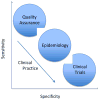Diagnostic Criteria for Acute Kidney Injury: Present and Future
- PMID: 26410133
- PMCID: PMC4584412
- DOI: 10.1016/j.ccc.2015.06.001
Diagnostic Criteria for Acute Kidney Injury: Present and Future
Abstract
Acute kidney injury (AKI) is a clinical diagnosis guided by standard criteria based on changes in serum creatinine, urine output, or both. Severity of AKI is determined by the magnitude of increase in serum creatinine or decrease in urine output. Patients manifesting both oliguria and azotemia and those in which these impairments are persistent are more likely to have worse disease and worse outcomes. Short- and long-term outcomes are worse when patients have some stage of AKI by both criteria. New biomarkers for AKI may substantially aid in the risk assessment and evaluation of patients at risk for AKI.
Keywords: Acute kidney injury; Biomarkers; Clinical trials; Dialysis; Mortality; Renal recovery; Renal-replacement therapy.
Copyright © 2015 Elsevier Inc. All rights reserved.
Conflict of interest statement
JAK has received grant support and consulting fees from Alere, Astute Medical, Bard and numerous companies developing treatments for Acute Kidney Injury.
Figures



References
-
- Diamandopoulos A. Twelve centuries of nephrological writings in the Graeco-Roman world of the Eastern Mediterranean (from Hippocrates to Aetius Amidanus) Nephrology, dialysis, transplantation : official publication of the European Dialysis and Transplant Association - European Renal Association. 1999;14 (Suppl 2):2–9. - PubMed
-
- Kellum JA. Acute kidney injury. Crit Care Med. 2008;36:S141–5. - PubMed
-
-
KDIGO AKIWG: Kidney Disease: Improving Global Outcomes (KDIGO) Clinical Practice Guideline for Acute Kidney Injury. Kidney inter., Suppl 2012;2 : 1–138. 1–141, 2012
-
-
- Eknoyan G. Emergence of the concept of acute kidney injury. Advances in Chronic Kidney Disease. 2008;15:308–313. - PubMed
Publication types
MeSH terms
Substances
Grants and funding
LinkOut - more resources
Full Text Sources
Other Literature Sources
Miscellaneous

